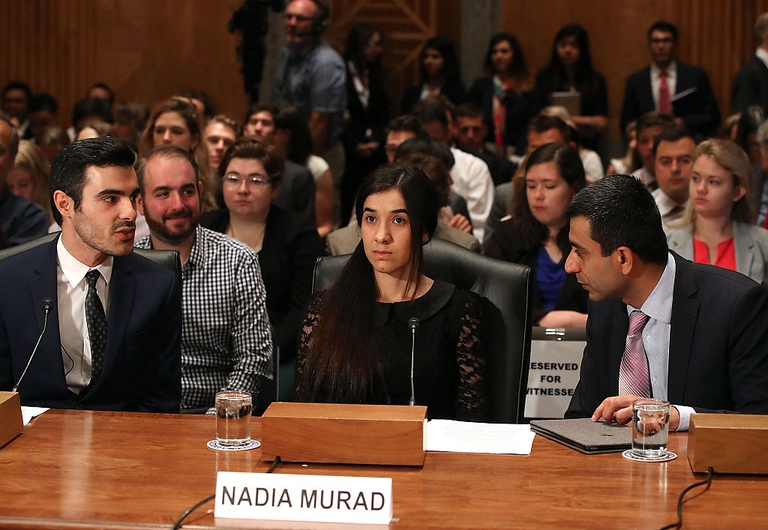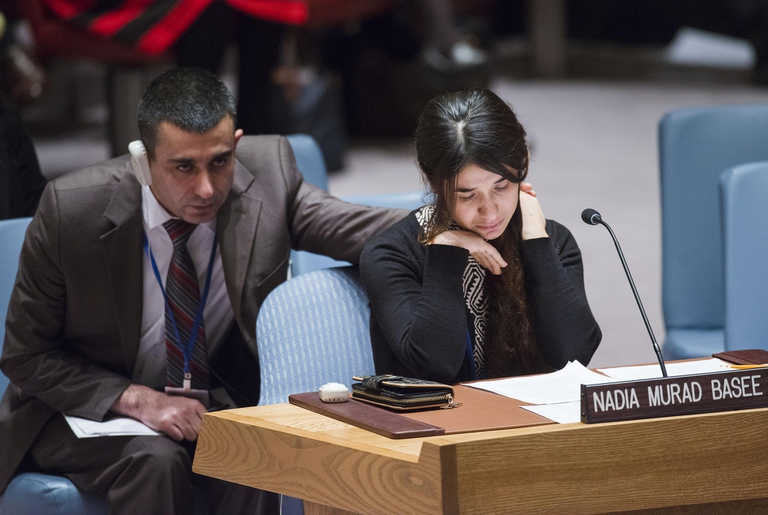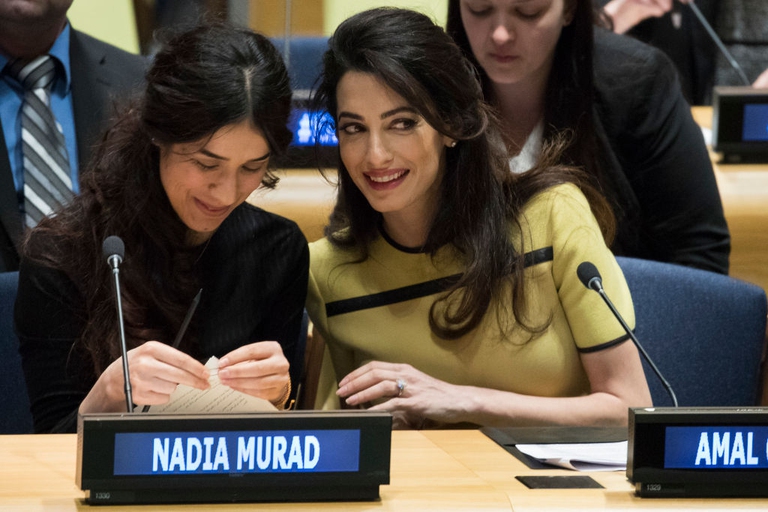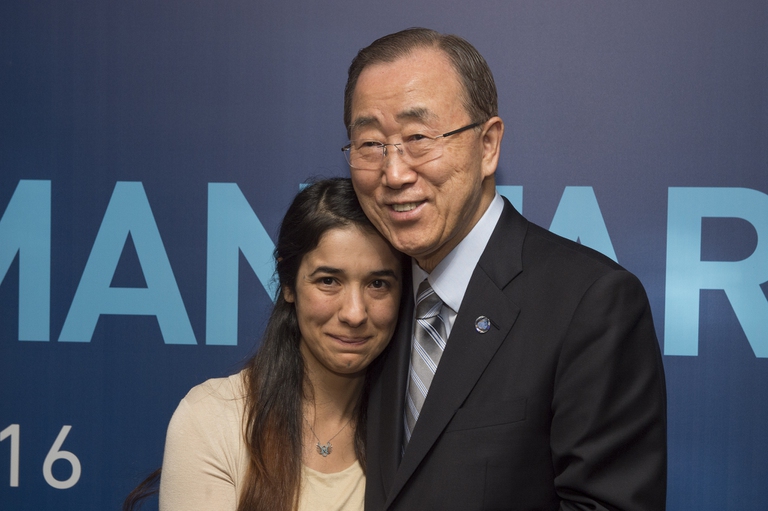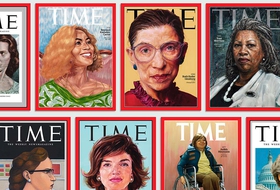
One in three women have suffered physical or sexual violence. With contributions from Europe, Africa, Asia and Latin America, we look at how this shadow pandemic affects every corner of the world.
Nadia Murad received the Nobel Peace Prize for her struggle in the name of her people, the Yazidi, and all victims of abuse. A battle to bring Isis, who made her a slave, to justice: but this is only the beginning.
Deciding to be honest was one of the hardest decisions I have ever made, and also the most important.Nadia Murad, The Last Girl
A young woman with superhuman courage. The courage to survive the enslavement and sexual violence the militants of the Islamic State (Isis, also known as Daesh) subjected her to. The courage to escape her captors and reach Europe. The courage to tell the world her story and that of her people, the Yazidi, in the name of justice.
For this courage, at the tender age of 25 Nadia Murad Basee became the first Iraqi to receive the most prestigious humanitarian recognition, the Nobel Peace Prize, last October. Together with Congolese gynaecologist Denis Mukwege she was chosen for her “efforts to end the use of sexual violence as a weapon of war and armed conflict”.
Read more: Denis Mukwege, 2018 Nobel Peace Prize winner, the doctor who “mends” women
“Rape has been used throughout history as a weapon of war,” Murad writes in her autobiography, The Last Girl. “I never thought I would have something in common with women in Rwanda – before all this, I didn’t know that a country called Rwanda existed – and now I am linked to them in the worst possible way”. The terrible story that connects Murad, the 3,000 Yazidi women sold as slaves by Isis and all the others around the world on whose bodies the most absurd war crimes have been consumed, began in 2014.
BREAKING NEWS:
The Norwegian Nobel Committee has decided to award the Nobel Peace Prize for 2018 to Denis Mukwege and Nadia Murad for their efforts to end the use of sexual violence as a weapon of war and armed conflict. #NobelPrize #NobelPeacePrize pic.twitter.com/LaICSbQXWM— The Nobel Prize (@NobelPrize) 5 ottobre 2018
Before, Murad dreamt of becoming a teacher or opening a beauty salon. But on the 3rd of August her small rural village of Kocho, together with many others in Sinjar, in northern Iraq near the border with Syria, was invaded by the Islamic State’s self-proclaimed caliphate. This is one of the areas in which the Yazidi population is concentrated: it’s estimated that around half a million people worldwide belong to this religious minority whose beliefs bringsì together elements of Christianity and Islam. For all their long history – theirs is one of the most ancient monotheistic religions – the Yazidis have faced attacks and discrimination at the hand of other groups, even labelled as “devil worshippers” by some.
Daesh came to kidnap, to murder, to rape. This was genocide, it is that simple.Nadia Murad
Thousands of Yazidis were killed in a few days, a few hours even, and Isis unleashed a fierce campaign to exterminate their culture, bringing the United Nations to label this as genocide. Now, even though the caliphate has been defeated by Iraqi and Kurdish Peshmerga forces with the support of international military coalitions, it is estimated that 3,000 Yazidi women, men and children remain in the Islamic State hands, whilst thousands others haven’t been able to return to their homes (in part because they fear a return of Daesh) and live in refugee camps.
The slave market opened at night … the militants touched us anywhere they wanted, running their hands over our breasts and our legs, as if we were animals.The Last Girl
At the age of 21, Murad was kidnapped by Isis, forced to convert to Islam and sold repeatedly as a sex slave. Not only did she lose her mother and six brothers, but also the chance of leading a normal life: “my life in Sinjar as a simple Yazidi farm girl is gone forever, the dreams and hopes of my whole community are gone”.
She managed to escape (taking advantage of a door left unlocked by one of her captors) in November 2014, crossing Iraqi Kurdistan to reach a refugee camp and then Germany, where she currently. From there, she began writing her new story. Marked by a trauma that could have annihilated her, she decided to show the world her wounds. With a clear purpose: to become an advocate for her people as well as all victims of human trafficking and violence.
My story, told honestly and matter-of-factly, is the best weapon I have against terrorism, and I plan on using it until those terrorists are put on trial.The Last Girl
She started telling her story, for example during a session of the UN Security Council in 2015, a little over a year since Isis tried to steal her identity from her forever. She became the first United Nations Ambassador for the Dignity of Survivors of Human Trafficking, an appointment she accepted in 2016 during a ceremony at the UN headquarters in New York, with her lawyer and supporter Amal Clooney by her side.
Every time she recounts the injustices she was subjected to, she relives the horror. “I cried when I heard her story,” Ban Ki-moon, former UN Secretary General, said. “But I didn’t only cry out of sadness. I was also moved to tears because Nadia has so much strength, courage, and dignity”.
Murad is fighting to “establish a safe zone for religious minorities in Iraq [and] prosecute Isis … for genocide and crimes against humanity”. An important milestone was laid in September 2017 with the adoption of a UN resolution to investigate the crimes committed by the Islamic State in Iraq. Murad founded Nadia’s Initiative, an NGO working for the rights of victims of abuse and those of the Yazidi people, donating her Nobel prize money to the Sinjar Action Fund created by her organisation, also thanks to the support of French president Emmanuel Macron.
Another mass grave that contains remains of Yazidis killed by ISIS was found yesterday in Tel-Azer village South of Sinjar. This adds to the tens of mass graves that have been discovered since 2014. The world failed to protect Yazidis, now the world fails to deliver justice. pic.twitter.com/HxZbFCSMjq
— Nadia Murad (@NadiaMuradBasee) 18 novembre 2018
The terrorists didn’t think that Yazidi girls would be able to leave them, or that we would have the courage to tell the world every detail of what they did to us. We defy them by not letting their crimes go unanswered.L’ultima ragazza
Murad is burdened by her atrocious memories as well as a strong sense of responsibility. Even though she’s received an outpouring of moral support, she needs more than just people’s empathy. She told her story to the world to obtain concrete actions so that she and other women who have survived abuse can take their lives back into their hands, as well as those of their communities. She escaped slavery, Isis and war not to remain a victim but to be come an activist, so she can be the last girl in the world with a story like hers.
Siamo anche su WhatsApp. Segui il canale ufficiale LifeGate per restare aggiornata, aggiornato sulle ultime notizie e sulle nostre attività.
![]()
Quest'opera è distribuita con Licenza Creative Commons Attribuzione - Non commerciale - Non opere derivate 4.0 Internazionale.
One in three women have suffered physical or sexual violence. With contributions from Europe, Africa, Asia and Latin America, we look at how this shadow pandemic affects every corner of the world.
The Istanbul Convention against gender-based and domestic violence marks its tenth anniversary. We look at what it is, who its signatories are, and what the future might hold.
European Commission President Ursula von der Leyen reminded us of the gravity of violence against women around the world, and of the Istanbul Convention’s utmost importance.
President Erdoğan has pulled Turkey out of the Istanbul Convention, key in the fight against gender violence, claiming that it favours the LGBT community rather than family values.
Violence against women in Peru has increased as a result of Covid-19 lockdowns. 14,912 people were reported missing from January to November 2020, more than half of them minors and 64 per cent women. People have been confined to their homes for months, many forced to endure poor physical, economic and social conditions. A situation that
Joys Estefani Qqueccaño Huamani, 24, disappeared from her rural community in Peru on 9 October. Her family began looking for her independently of the authorities and despite the resistance of relatives of Joys Estefani’s ex-partner Arturo Ccana Condori, 32, charged with committing violence against her on 28 September, eleven days before Joys Estefani disappeared. Photos
Costa Rica celebrated its first same-sex marriage when two women, Alexandra Quiros and Dunia Araya, celebrated their wedding: an “extraordinary moment”.
The pandemic and its restrictions are affecting everyone, without exceptions. However factors like housing, income inequalities, gender, access to technology and working conditions are influencing how people experience the health crisis.
Time magazine’s 100 Women of the Year project sheds light on influential women’s stories, from Amelia Earhart to Greta Thunberg. A selection of some of the greats for International Women’s Day.
